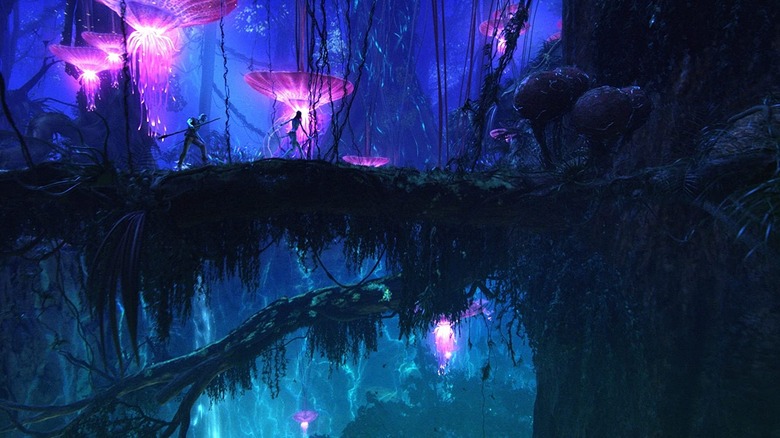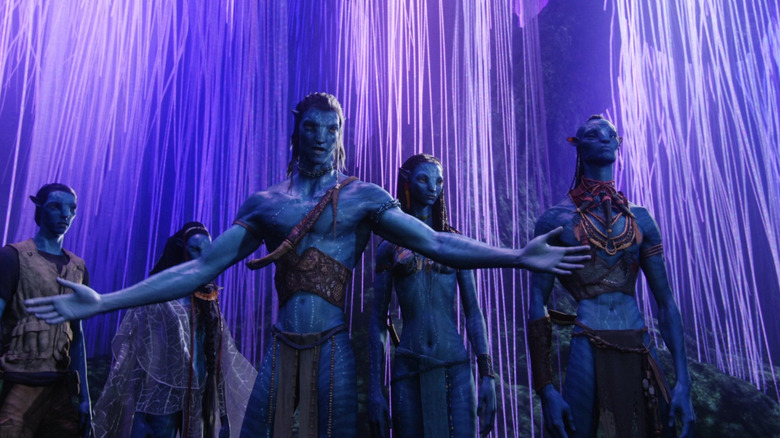James Cameron Wasn't Very Concerned With Explaining How Avatar's World Would Work
One might be able to blame the ascendency of geek discourse for this, but many conversations about sci-fi and fantasy properties have begun to skew incredibly literal. This may only be based on anecdotal evidence, but a recent conversation (on social media, natch) about the upcoming film "Black Panther: Wakanda Forever" calls into question Shuri's ability to best Namor in hand-to-hand combat. This sparked a miniature conversation about how audiences need to witness training and preparation in order to understand preparation happened. Audiences, it seems, would prefer not to fill in the gaps with their imagination. Of course, as Stan Lee himself helpfully pointed out, the winner of the fight is whoever the writer wants. Let's not get hung up on technicals.
But getting hung up on technicals is the bread and butter of nerds. Where would Trekkies be if we couldn't bicker over the way warp engines work? Where would "Star Wars" fans be if they couldn't debate the fineries of the Force? And where would "Avatar" fans be if ... actually, thanks to James Cameron's overwhelming abilities to envision Pandora as a place of beauty, few of the movie's fans seem terribly concerned with Na'Vi biology, the nature of their psychic tendrils, or how far the planet is from Earth from a practical space travel standpoint.
In a 2010 interview with Terry Gross on NPR, Cameron stressed that the world "Avatar" was not based in hard sciences, coming instead from a more dreamlike, imaginative place. Cameron was only concerned about the fable-like qualities of "Avatar" that lent it storytelling possibilities and the potential for unique imagery. Physics, as an viewer of "Avatar" may glean, were hardly a concern.
In dreams, I walk with you
This may be an odd sentiment from Cameron who, as his filmography bears out, is a filmmaker obsessed with technology. As has been mentioned in the past, Cameron felt he needed to wait for film tech to advance far enough in order to envision what he wanted to bring to the screen in "Avatar." The same might hold true for the upcoming sequel, "Avatar: The Way of Water" and even the FX bonanza "Alita: Battle Angel," a project he handed off to director Robert Rodriguez.
When Gross asked Cameron the very general question about whether he had an active dream life, Cameron became incredibly eager to talk about his dreams. "Avatar," he said, came from that dream, and that the artistic media he had immediately at hand was not adequate for capturing his vision:
"Very much so ... A lot of the imagery in 'Avatar' comes from dreams that I've had over time. I can remember distinctly having a dream in college of a glowing, bioluminescent forest and getting up and very quickly sketching it with oil pastels, trying to get the colors down, trying to get, you know, what I had imagined in the dream down on paper and feeling this great sense that I hadn't succeeded. It just was this ugly thing. It wasn't what I had seen in the dream.
This falls in line with several notable film theories that state the medium is best meant to translate human dreams. Robert Curry's 1974 essay "Film and Dreams" expands on this notion considerably and it a must-read for anyone interested in criticism.
Cameron and surrealism
While one might never call Cameron a surrealist — not by a long shot — he does appear to subscribe to a mindset adopted by the early surrealist movement, specifically that art is a way to more directly access the subconscious. Early surrealists would practice "automatic writing," attempting to get words on the page without adding any kind of conscious thought to them. The movement of mind imagery directly into a physical artistic medium was exactly what Cameron felt he was doing with "Avatar." His dreams took place on Pandora. Using compucated technology, he brought his dreams to life. From the NPR interview:
"I know the surrealist artists strongly believed that their mission was to translate to the canvas images they'd had in dreams without any attempt to analyze or mediate them and that that was kind of their ethos, and I kind of adopted a little bit of that when I was making 'Avatar.' I thought, you know, if I like an image, I'm going to put it in the movie, and I'm not going to try to justify it."
Indeed, the "justification" of such imagery appears to be antithetical to Cameron's filmmaking ethos. He may be obsessed with the technology used to make movies, but he will not delve into the meaning or the science of those images. For Cameron, the images are enough.
In a sci-fi film, one may complain about how unobtanium is not properly explained, or how Earth was never depicted (except briefly in the film's director's cut). Those notions, for Cameron, would stand in the way of the beauty of Pandora. And even the grumpiest of "Avatar" critics will have to admit that Pandora is staggeringly beautiful.
Floating mountains
There are a few have-wavy scientific explanations in "Avatar," of course. It's explained that Sully (Sam Worthington) is required to shunt his mind into a Na'Vi/human hybrid clone because he is the only one able to after the death of his twin brother. Since he and his brother shared DNA, he is able to "pilot" the Na'Vi body. It's also explained that the Na'Vi live in harmony with the planet because of a literal psychic connection they can arrange via their head tendrils. The actual nature of the tendrils is never quite explained other than it being a means to psychically bond with a tree, an animal, or another Na'Vi. Unlike "Star Trek," there is no multisyllabic technobabble to explain it. For Cameron, it just is.
In the NPR interview, Cameron said, very explicitly he didn't want to explain stuff:
"So, you know, you see floating mountains in the film. They're never explained. Now, I happened to have, you know, sort of reverse-engineered a scientific explanation of how those mountains float, but every time I tried to shoehorn it into the movie, I just found that it was unnecessary explanation. People would accept that they had been transported to this amazing place where the rules were different, and it was okay for mountains to float. And it turned out that that technical explanation was completely unnecessary."
Cameron does have a point. There are those among us who awaken from a dream and shift into Freud mode, immediately unpacking where the symbols come from. And there are those who awaken, and take a moment to let the pleasant, beautiful surreality of the dream wash over them. Cameron is of the latter camp.



